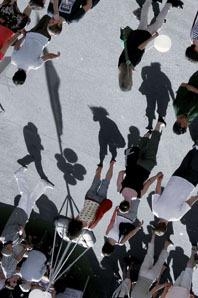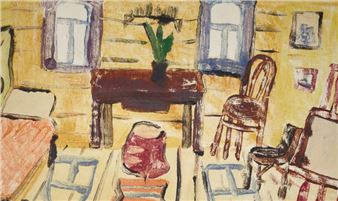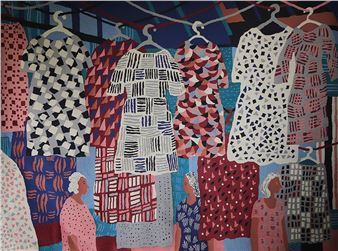Julia Kissina: Shadows Cast People
The spectral life of a persons doubles turns out to be surprisingly dense, expressive and organized. The very appearance of shadows assumes various forms  sometimes an unexpected monumentality, which the flattened prototype is lacking, sometimes eccentricity ranging from gargouilles to the participants of an improvised circus show, sometimes the mechanism of everyday activities laid bare before the viewer. It is true that the series effect is revelatory. The viewer seems to occupy two levels simultaneously. First of all, he or she is allowed to follow the development of a full-fledged plot: in one of the images someone has raised his dagger or blade (the magical transformation of a simple umbrella or cane), in another an extremely long arm is stretched out (a passer-by is engaged in handing out leaflets), in a third we see a pair of arms resembling branches, and of course they are raised with a reason Centaurs and guardsmen appear on the stage, at some point enter executioner and unidentified character in livery. Dont lose your attention!
But this theater reminiscent of optical toys and the time anterior to cinema is not enchanting by itself. Having discarded man, having literally cast him aside, it still remains supplementary to the source that it suppressed. For the theater is born in the very heart of the everyday, and its backdrop, if one is to slightly readjust oneÔÇÖs vision, is the ordinary flagstone urban sidewalk. The shadow theater that has secretly taken shelter in the rays of the afternoon sun tells the phantasmagoria of banality itself. It is the invisible side of our existence that no one cancelled, to be sure. In order that this dimension, this distance from the self be discovered at the site of greatest intimacy, it is necessary to equip oneself with one of those devices that grasp but also mediate everyday experience. The camera helps Julia Kissina to reveal the subtlest mechanism ÔÇö that of the spectral in the everyday.

The spectral life of a persons doubles turns out to be surprisingly dense, expressive and organized. The very appearance of shadows assumes various forms  sometimes an unexpected monumentality, which the flattened prototype is lacking, sometimes eccentricity ranging from gargouilles to the participants of an improvised circus show, sometimes the mechanism of everyday activities laid bare before the viewer. It is true that the series effect is revelatory. The viewer seems to occupy two levels simultaneously. First of all, he or she is allowed to follow the development of a full-fledged plot: in one of the images someone has raised his dagger or blade (the magical transformation of a simple umbrella or cane), in another an extremely long arm is stretched out (a passer-by is engaged in handing out leaflets), in a third we see a pair of arms resembling branches, and of course they are raised with a reason Centaurs and guardsmen appear on the stage, at some point enter executioner and unidentified character in livery. Dont lose your attention!
But this theater reminiscent of optical toys and the time anterior to cinema is not enchanting by itself. Having discarded man, having literally cast him aside, it still remains supplementary to the source that it suppressed. For the theater is born in the very heart of the everyday, and its backdrop, if one is to slightly readjust oneÔÇÖs vision, is the ordinary flagstone urban sidewalk. The shadow theater that has secretly taken shelter in the rays of the afternoon sun tells the phantasmagoria of banality itself. It is the invisible side of our existence that no one cancelled, to be sure. In order that this dimension, this distance from the self be discovered at the site of greatest intimacy, it is necessary to equip oneself with one of those devices that grasp but also mediate everyday experience. The camera helps Julia Kissina to reveal the subtlest mechanism ÔÇö that of the spectral in the everyday.
Artists on show
Contact details


 ARTISTS
ARTISTS










